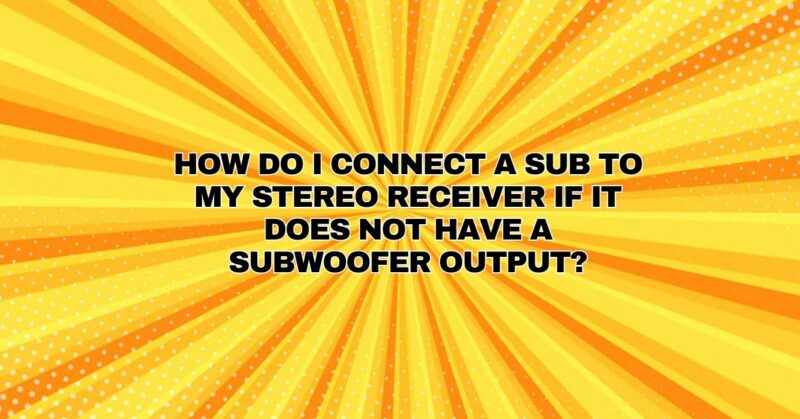Adding a subwoofer to your stereo system can significantly enhance your audio experience by delivering deep, powerful bass that traditional speakers may not reproduce as effectively. However, not all stereo receivers come equipped with a dedicated subwoofer output. If you find yourself in this situation, don’t worry—there are still several ways to connect a subwoofer to your stereo receiver and enjoy that low-frequency punch. In this article, we’ll explore various methods for achieving this connection.
1. High-Level (Speaker-Level) Inputs
Many subwoofers are equipped with high-level (speaker-level) inputs, allowing you to connect them to your stereo receiver’s speaker outputs. This method involves connecting the subwoofer in parallel with your main speakers. Here’s how to do it:
a. Identify the Speaker Outputs: Locate the speaker outputs on your stereo receiver. These are usually color-coded and labeled as “Front” or “Main.”
b. Determine the Appropriate Speaker Outputs: Decide which pair of speaker outputs you want to use for your subwoofer. Typically, you’d choose the front speaker outputs since they handle the full range of audio frequencies.
c. Connect Speaker Wire to the Subwoofer: Using speaker wire, connect one end to the chosen speaker outputs on your receiver and the other end to the high-level inputs on your subwoofer. Ensure that you connect the positive (+) terminal on the receiver to the corresponding positive terminal on the subwoofer and the negative (-) terminals in the same manner.
d. Set the Subwoofer’s Crossover and Volume: On your subwoofer, set the crossover frequency and volume controls to your preference. The crossover determines the frequency range that the subwoofer handles, so set it to the low-frequency range you desire.
e. Configure the Receiver: Some stereo receivers have a “Subwoofer On/Off” or “Bass Management” setting in their menu or setup options. Make sure the subwoofer is enabled in these settings.
2. Using a Line-Level Converter
If your subwoofer lacks high-level inputs or you prefer an alternative method, you can use a line-level converter to connect the subwoofer to your stereo receiver’s RCA outputs. Here’s how:
a. Obtain a Line-Level Converter: Purchase a line-level converter, also known as a high-to-low-level converter. This device takes the high-level speaker output from your receiver and converts it into a line-level RCA output that can be connected to your subwoofer.
b. Connect the Line-Level Converter: Connect the speaker-level inputs of the line-level converter to the speaker outputs on your receiver. Ensure that you match the positive and negative connections correctly.
c. Connect the Line-Level Output: Attach an RCA cable from the line-level converter’s RCA output to the RCA input on your subwoofer.
d. Adjust Subwoofer Settings: Set the subwoofer’s crossover frequency and volume controls as mentioned earlier.
e. Configure the Receiver: Ensure that your receiver’s settings are adjusted to accommodate the subwoofer, enabling bass management if available.
3. Subwoofer with Stereo Input Option
Some subwoofers come equipped with stereo input options, allowing you to connect them directly to your stereo receiver’s line-level outputs. This method eliminates the need for a line-level converter and simplifies the connection process:
a. Identify Stereo Inputs: On your subwoofer, locate the stereo (left and right) line-level inputs.
b. Connect RCA Cables: Use RCA cables to connect the left and right line-level outputs on your stereo receiver to the corresponding inputs on the subwoofer.
c. Configure the Subwoofer and Receiver: Adjust the subwoofer’s crossover and volume controls as needed. Ensure that your receiver is configured to use the subwoofer and manage the bass frequencies properly.
4. Use a Dedicated Subwoofer Amplifier
If none of the above methods work for your setup, you can consider using a dedicated subwoofer amplifier. This approach involves connecting your stereo receiver’s preamp output to the subwoofer amplifier, which then powers the subwoofer. It offers more control over the subwoofer and can be particularly useful in advanced audio setups.
Conclusion: Enhanced Bass Without Subwoofer Output
While it’s ideal to have a stereo receiver with a dedicated subwoofer output, not having one doesn’t mean you can’t enjoy enhanced bass in your audio system. By using high-level inputs, line-level converters, subwoofers with stereo inputs, or a dedicated subwoofer amplifier, you can successfully integrate a subwoofer into your stereo setup. With proper configuration and calibration, you’ll be able to experience the full depth and impact of low-frequency audio content, enhancing your overall listening experience.


